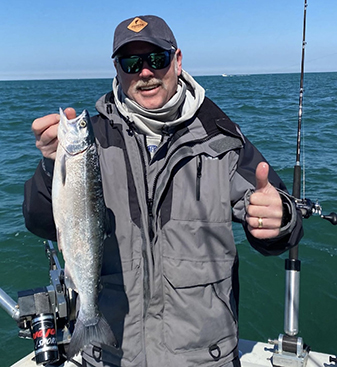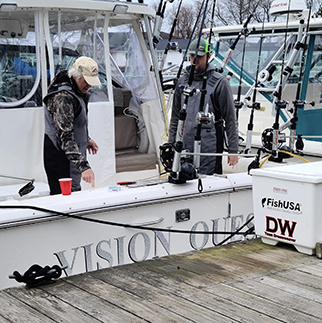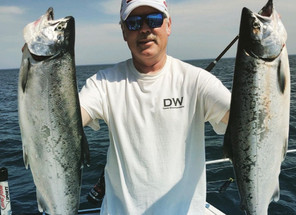Posted by Chris Larsen on 28th Mar 2023
Coho Salmon Fishing With Captain Pete Alex
Coho Salmon are one of the most popular species of game fish on the Great Lakes. They’re known for being ultra-feisty in the water and delicious on the plate. We discussed coho salmon fishing with Captain Pete Alex from Vision Quest Sport Fishing on the Great Lakes Fishing Podcast. Pete has a passion for cohos and you can listen to the entire conversation by clicking here.
Pete fishes both Lake Erie and Lake Ontario. They do catch a few cohos on Erie but it’s mostly a walleye, steelhead, and laker fishery for Vision Quest. “So, last year we had a real small pod of salmon out on our offshore waters, and we tapped into that a little bit, running some of the same equipment or gear & lures that we would run on Lake Ontario. We were able to catch some. I think we caught about 13 or 14 cohos last year on Erie.”

Most of the cohos that Alex’s customers catch are on Lake Ontario. During the interview, I asked why even bother with coho salmon when you have a legendary king salmon population on Lake Ontario. “That's a good question, it's great king fishing a lot of times, but not all the time, especially earlier in the season when the kings haven't showed up in good numbers yet, the cohos are typically there. So, we will target more cohos and less kings, and then at some point in the year when they start to thin out and head down east or across the lake over towards Toronto, or as they work their way eastward, we're left with fewer kings. But sometimes we have cohos too. So, we'll start running a joint program or a dual program trying to target both those species to fill our box and to have fish to catch for our customers or in a tournament.”
Captain Alex fishes out of Wilson, New York. He says the coho fishing starts early in the season. “They'll be there at some point in April, usually towards the end of April, that's when I'll put the boat in the water and start fishing. So, prior to that, they seem to be offshore, and at some point, they're triggered to come in, and we'll have cohos on the west side of the Niagara River at the west end of Lake Ontario, where they're in the warming water over there, and then towards the end of April they'll start to migrate or come in from the offshore and they'll start to show up in our waters, which is typically sometime in April.”
Coho Salmon Fishing Tips
Cohos can be tough to pattern. Alex says this is what he enjoys about fishing for them.“We cover a lot of water typically, if you find a couple, you're going to find a lot more, but you'll find them in the green fertile water. You'll catch these fish out in what I call the death water, the black ice water, which, you know, you're shaking your head wondering why they're out in 40 degrees surface water when half a mile in they can find 45 or 46 fertile looking water. But they're cohos so that's what they do. And so really we cover a lot of water. We'll fish in the upper end of the water column to find these fish. But the key is, if you find a few, just to work that spot until it dries up.”
Wilson, New York is a fantastic location that’s within easy reach of the Niagara Bar and the blue water fishery. Alex says he doesn’t have to go far to find fish. “So, out a Wilson typically we're not going to go too far from the port. Wilson's about 11 to 12 miles east of the Niagara Bar. So, we won't typically run all the way down to the bar when we start to look for cohos. We're going to be in that Wilson area, and then we're going to work our way westward or actually northwesterly. But at some point, the cohos do light up at the bar and it's pretty good fish in there. But typically when we leave the pier to fish cohos we're not very far from the port.”
Captain Pete Alex believes a diverse spread is the key to putting more cohos in the boat. “Typically we're going to run what we call a super spread. We're going to have lines from the surface down to what we feel is the ice water, which might be 39 degrees, especially in the spring. So, we're going to put a pretty big spread out, but probably 75% of our baits are going to be in the top, that top 30 foot of water. We're going to be running planer boards primarily inline boards with surface lines, which could be just monofilament rods with stick baits, back eighty to a hundred feet. We might be running spoons with split shot rigs off inline boards with orange back or smaller spoons or plugs. Fishing again, the top sixty feet, and we might be fishing with a variety of what we call short cores, two cores, three cores, or five cores off those boards. We’ll run dipsy divers. We'll keep those from 25 to 60 feet out. We'll run three riggers. We'll park a couple deeper and we'll park a couple near the top, and then we'll run a higher running chute rod, which could be a five-core or three core right down the middle, again, with a high coho type lure or attractor.”
Coho Salmon Fishing Lures
Cohos can be caught on a variety of lures and presentations. Pete shared some of his favorites with us. “If we're running spoons off our short cores or our high riggers with sliders, we're going to run a lot of Super Slims. We're going to run you know, a lot of steelhead type colors, it's Mixed Veggies, and a Super Slim, Double Lemon Ice, like a chartreuse. A really good coho spoon is your typical oranges. This is an orange UV Super Slim. Then we'll run some salmon-type spoons, especially in the morning. This is a Green Gator and we have a Moon Cricket. Those will take fish in the morning, and then will start to fizzle. So, we'll run a variety of steelhead-type coho spoons, like Whiteback Frog. This is usually a very good morning spoon for cohos. We'll run what we call hot back spoons, these bright orange backed spoons. At some point we're going to be fishing a lot of attractors, these little Spin Doctors from Dreamweaver, these are six inches. So, we'll start to deploy these. Again, we're going to run these divers, maybe on our out and downs three cores or five cores up in the top 25 feet of water. So, we like to run these, and occasionally we'll run the Lake Michigan favorites, these six-inch high-vis orange dodgers with peanut flies. The one reason we don't pull a lot of these in Lake Ontario is we like to cover water quicker. If you're gonna run these dodgers, you kind of have to slow your trolling speed down a little bit too. That's where the Spin Doctors come into play. We're able to troll a little faster to complement our spoon program at the same time.”
These days, it's hard to beat Lake Ontario salmon fishing. One of the aspects of coho fishing that Alex likes best is the fast action. “What makes coho fishing fun is the fact that they're fearless. They're not boat shy, they're not line shy necessarily, and they fly into your prop wash. They're pretty fearless, so they're not really boat-shy. They seem to be boat shy in a tournament though, but not necessarily day in and day out.”
When asked why peanut flies are so popular for coho fishing, Pete says it’s just a matter of what cohos eat. “Coho are a smaller fish in general, especially in the spring. They're from 15 to 22 inches in the spring, depending on the type of year they had, if they were able to eat a lot, how the spring was for them. So, they're a smaller fish. They like smaller things. They eat a lot of bugs and stuff off the surface. They like emerald shiners, which are small, especially in the spring. So, generally, they're geared towards a smaller bait, not always, but probably a day in, day out, the smaller the better for cohos.”
Cohos are known for having a voracious personality. They like to eat and go after baits. When the bite is hot, coho fishing can be as good as it gets. Alex agrees. “If you chartered my boat and said, I don't want to catch kings or lakers, let's just go out and catch cohos, I'm going to get excited because not a lot of people like to fish for them necessarily, especially when there are kings around. So, to me, they're a little bit of a niche fish once in a while for people because not everybody's geared to want to go catch them. The big kings will have sizzling runs, that's great. But when it's all out coho mode, I guess it's just exciting. It's a different presentation. Sometimes it's a little bit of a challenge because you're fishing for a fish that's nomadic, hard to find, and hard to dial into but they're a blast when you catch them. I mean, you can troll two hours, not get a bite and just keep trolling north to the promised land and you'll catch six in two minutes and you'll get a hit on a diver, you know, and they'll hit, they'll smack a diver on the surface you'll be netting another fish, slowing the boat down, and they'll whack something else. They're just spastic. They'll charge the boat, they'll get into your cables. People will have a tough time handling them, especially the big ones. So, it's a more exciting fish. You know, kings, they hit hard, they make straight line runs most of the time, which is great. But cohos are just different animals. They jump, they do crazy things, they charge a boat, they do circles, they spin, and then they hit a lot of different baits close to the boat.”
When it comes to Captain Alex’s best trolling speed for coho salmon, it depends on what he’s pulling behind the boat. “I'm going to say that 2.2 to 2.5 range. Especially if we're running some dodgers or the small Spin Doctors, we're going to keep it toned down a little. If we have primarily a spoon program out and we're covering water, we might tune it up to three miles per hour.”

Later in the conversation, we had a question about the Vision Quest fleet. Pete has several boats which gives him options. “I have a 2700 Tiara, which we just repowered a couple of years ago. Great boat, I call it the best big little boat there is made. Love that boat, it's mobile. I'll fish that boat early in the spring and then late in the fall when the marinas close. So, that's my early and late season boat, and then a couple of times I've had motor issues with my 36 Tiara so, I've had to deploy that to run my trips. That's been a great boat for me. Love it. I have a 31 Tiara that I keep on Lake Ontario that's year around another great boat. Knock on wood, that boat's been great since the time I've owned it. Quiet, sweet running boat. And then I have the big girl, which is the 36 Tiara Diesel. It's given me some issues over the years with the motors. Cost me some jing, fixing those motors. But a great fishing platform. It’s a big water boat and there's a lot of days I'm on the water and guys are tied up dockside because the water's too big and we're out there killing fish.”
In fishing and in life, it’s often the little things that make a big difference. I asked Captain Alex what he sees when he sees small mistakes inexperienced anglers make. “Well, I think a lot of people don't pay attention to the little things. Leader line type fluorocarbon lines size of swivels or some basic things I see people just totally whiff on. Diver leader length is a big one. I see people whiff on. They run seven or eight-foot diver leader line. I use more. I call it two lengths, which is about 12 feet. It's a little harder to fish. But I think day in and day out leaders that are right on that 12-foot work very well in Lake Erie and Lake Ontario. But I see a common problem with new anglers is they have baby leaders. They are highly ineffective for the most part except in cases where fish are dumb and they eat everything. There are people who chase walleye all the time and they never check to see if their crankbaits are tuned up. Little things you know, pull them alongside the boat, make sure they're tuned up. Even stick baits, make sure they're tuned up so a lot of people fish on the blind. They're fishing baits that aren't really running right in the water.”
Preparation before the trip is also key to making the most of your time on the water. “People are pretty amazed at the efficiency on the boat. We were kind of a machine, we don't have a lot of dead time in the water. We're constantly deploying and redeploying rods in and out to make use of that time. Rods out of the water are rods you're not going to catch a fish on. Sometimes I harp on my mate. We'll catch a walleye or two, and he has the plugs stuck on the guide sitting in a rod holder. And I told him, I've never seen a fish jump out of the water and grab a lure that's attached to a rod in the rod holder. So, he gets the point then. So some things about efficiency and time and deploying, and improving your game. You know my game, I'm always looking to improve my game, my efficiency as an angler. I have not hit the peak and or the plateau of saying I'm too good or I'll never learn, or I'm done learning. Never, ever. So, anglers who want to get better, really need to put the time in the water. They need to attend seminars, and videos listen to the podcasts that you do and pick up on a lot of these little key things that'll help them put more fish in the boat.”
Having a lot of lines in the water can definitely increase your catch rate but Alex says rod management is vital. “You want to air your program out. The more lines, the closer they are equals catastrophe. Especially if you get a rogue king. You're trying to fish cohos with a big spread, and you get a king to eat your program and just blitz everything which happens. So, the more you can spread things out you're going to avoid tangles and catastrophes. That's one thing. Sometimes airing it out helps you produce more fish. When you spread things out, spread your divers, your riggers, and your board lines out. So, that'll help you as well. Only run as many rods as you can manage without causing yourself chaos or downtime, and then some of that takes time to develop how to run things like double sets of divers.
Some people struggle running four dipsy divers at once. They get tangles, and they get frustrated. So work that into your system where you have a good two-diver program. Now play with running two more divers. Talk to people, see how they do it, and take their tips. If you're running a lot of planer board lines, there's techniques. You have to keep those lines spread out. When fish bite, sometimes you have to be more patient to let them clear over the inside line so you don't bring in your whole spread or planer board lines. Some of that is just trial and experience to help you manage running big programs. But, you know, every once in a while we'll run big programs and we get in trouble with them.
We'll get fish that do bad things and cause chaos. We put a lot of water time out there and generally, we see it coming so we'll, we'll clear lines. If we see a bad fish or a bad event happening, we'll start, moving lines out of the way to avoid chaos or a catastrophe. But work your way into it, don't just try and fish 12 rods. If you're a six-rod guy, you're probably going to get in trouble and work your way up until you get a program and you're efficient with it.”
To see the entire interview, click the player below.

